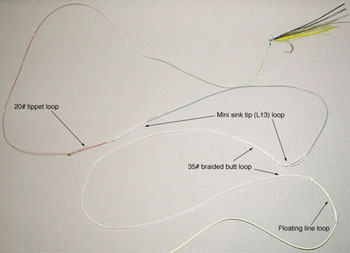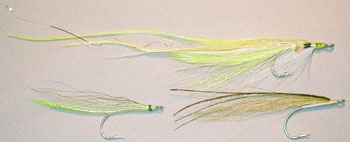by Mark Gustavson
| ||
| My favorite kayak fishing for stripers in Moriches Bay is around the flats. It is the ultimate in stealth and is real hunting/fishing. Even though the kayak's design offers stealth, the fisherman/paddler must avoid paddling over pods of stripers or even getting too close. Furthermore, avoid splashy paddling and cut down on strokes.
There are two ways I work a flat from a kayak. One is to anchor and cast from the kayak. The other way is to beach the kayak or anchor it and get out and wade. There is one possible danger to wading the sand flats of Moriches Bay and that is liquid sand. In such areas footing can be difficult to maintain and it would be prudent to continue to wear a PFD. Wading allows for more mobility and is more comfortable than being in the kayak. At the peak of summer one can wade the sand flats with just shorts or long polypropylene pants and some sort of kayak footwear to protect one's feet from crabs and possible debris. Waders or a wet suit are over kill under the blazing sun. Just check the water temperatures before heading out and know that the temperatures are cooler around the inlet on incoming. Casting from a Kayak Knowledge of the flats must be had before attempting to fish it. Take a trip without fishing gear. Bring a map of some kind or a GPS and take notes of depth, locations of sand bars and holes and there relationship to tides and moon cycle. For example, when does a certain sand bar appear on the drop or when does a certain sand bar disappear on the rise. Look for edges around the flat. It is almost a given that if there are stripers one will spot them cruising the edges, in particular, when the tide is changing and they are repositioning. I find spotting pods of stripers to be exhilarating. These pods may have up to seven fish and some up in the mid twenty pound class. By devoting a day of kayaking without fishing around flats or any structure will pay off big time on future fishing trips. One will discover that there are large areas of flats that just never hold fish and these areas need to be edited out in order to devote time to productive water. Flats are in constant flux and certain areas are only productive for a few days to maybe a week. Some areas only work on certain tides. Once I was hopping from one sand bar to the next and I was amazed at how quickly a sand bar could be overwhelmed by water. I would pick up anchor and move to the next sandbar. Within an hour there were no more exposed sand bars. Certain areas hold for ten minutes then the fish move on. To succeed at this type of fishing one needs a plan based on tides and their affect on sandbars and current. I choose to anchor in spots that allow me to work a long edge. I situate the kayak in such a way that I can cast on the flat and let the current take the line over deeper water where the stripers are holding. I will also look for humps and anchor so my line will sweep across the hump to stripers waiting to ambush bait. For both situations I use a floating line and dead drift the fly with an occasional twitch. I let the current present the fly to the stripers. As I stated earlier, flats change rapidly and timing is everything. If one is confident in their setup and cast, then do not spend too much time in one spot. Many times, when I time it right, I will get hook ups on the first cast. Then there are times where nothing happens and I move on after 15 minutes. I prefer fishing flats when the current is moving fast which starts around two hours after the tide change. When I fish I rarely use a weighted fly. I use non-weighted flies because they have greater movement and fluidity and I mostly use drifting presentations rather than retrieving or jigging. Part of the flats game is getting the fly to overcome the strong current and down to where the sand eels are schooling. One proven way is to add split shot to the line. Start with one split shot and then add another and another until the hits come. This approach is the same as nymphing. |
Another way is to interconnect a mini sink tip into the leader. This method is borrowed from steelhead fishing when the fish are on the bottom.
 One can add piece after piece or have some 3 to 5-foot long pieces. Split shot will get the fly down fast but sometimes the stripers react to something sinking more slowly. Only time on the water and experimenting will bring about consistent results. Stripers have Moods? For whatever the reason is, stripers have moods or something similar to them. One day the fish are fearless and are tailing right next to the kayak and only move when the paddle accidentally hits them or near to them and the the next day they are darting in all direction when the kayak is in sight. Fishing is certainly easier when stripers are in a positive mood and do not take notice of our presence and go about feeding. When they are negative they tend to be agitated and weary. One will notice that they are not holding in feeding lanes. They are simply not eating. On these days fishing is difficult and getting skunked on flats is possible. If this circumstance is encountered, keeping distance from the stripers is a must. Anchor as far away as possible. Try to false cast once and do it over an area that is void of stripers. One can also cast quartering down current and then feed line into the drift to reach the targeted area. Success may be one fish but that one fish will be well earned. Flies and Equipment The following flies have worked most consistently for me, Ray's Fly in various sizes, Frank Woolner's Sand Eel using fluorescent yellow mylar tubing to match the sand eels or Abrames' L & L Special will take fish regardless of the forage. In June and July chartreuse and yellow patterns between 3 and 5 inches work very well.  Some equipment choices are based on confidence and leaders and their materials is one of them. I prefer Seagaur 15# fluorocarbon for tippets on the sand flats due to its non glare and sinking qualities. UV sunglasses are a must for kayaking fishing. Brown and copper lens seem to offer the best contrast on sand flats. Use plenty of sunscreen, wear a wide brimmed hat and have plenty of drinking water. There is no where to seek shade on the flats and staying sharp is key to kayak safety.  © 2006 by Mark Gustavson | |
[ Stories & Essays ] |
||